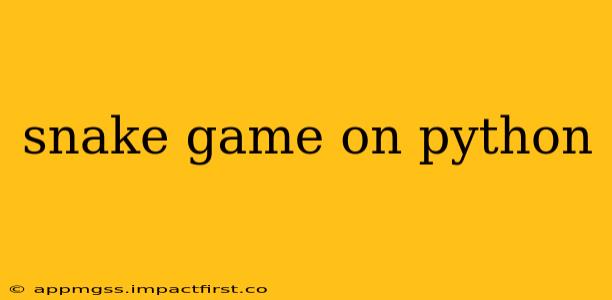The Snake game, a timeless classic, provides a fantastic entry point into the world of Python game development. This guide will walk you through creating your own version, explaining the core concepts and offering insights into improving your game. We'll cover everything from setting up the game window to implementing the game logic and enhancing the user experience.
Getting Started: Setting Up the Environment
Before we dive into coding, ensure you have Python installed on your system. You can download it from the official Python website. We'll be using the pygame library, a powerful tool for creating 2D games. Install it using pip:
pip install pygame
Game Structure: The Foundation of Your Snake
Our Snake game will consist of several key components:
- Game Window: This is the display where the game unfolds. We'll use
pygameto create and manage this window. - Snake: This is the player-controlled entity, represented by a sequence of squares (segments).
- Food: The objective of the game is for the snake to consume the food, which increases its length.
- Game Logic: This encompasses the rules of the game, including movement, collision detection, and scorekeeping.
Creating the Game Window with Pygame
Let's begin by creating the game window:
import pygame
pygame.init()
# Set window dimensions
window_width = 600
window_height = 400
window = pygame.display.set_mode((window_width, window_height))
pygame.display.set_caption("Snake Game")
This code initializes Pygame, sets the window size, and titles the window.
Representing the Snake
We'll represent the snake using a list of coordinates:
snake_x = window_width / 2
snake_y = window_height / 2
snake_size = 10
snake_list = []
snake_length = 1
Each element in snake_list will be a tuple representing (x, y) coordinates of a snake segment.
Adding Game Logic: Movement and Food
The core game logic involves handling user input for snake movement, detecting collisions (with food and itself), and updating the snake's position:
# ... (previous code) ...
# Game loop
game_over = False
clock = pygame.time.Clock()
while not game_over:
for event in pygame.event.get():
if event.type == pygame.QUIT:
game_over = True
if event.type == pygame.KEYDOWN:
if event.key == pygame.K_LEFT:
# ... (handle left movement) ...
# ... (handle other directions) ...
# ... (movement logic, collision detection, drawing) ...
pygame.display.update()
clock.tick(15) # Frames per second
pygame.quit()
quit()
This loop continuously checks for events (like key presses) and updates the game state. The clock.tick(15) limits the frame rate to 15 frames per second.
The complete code, including handling movement, food generation, collision detection, and scoring, is too extensive to include here but can be found in numerous online tutorials and repositories.
Improving the Game: Enhancing the User Experience
H2: How can I make my snake game faster?
Increasing the value within clock.tick() will speed up the game. A higher number means more frames per second. However, excessively high frame rates can make the game difficult to play. Experiment to find a balance.
H2: How do I add a score to my snake game?
You can implement scoring by incrementing a variable each time the snake eats food. Display this score on the game window using pygame.font.
H2: How do I make the snake game harder?
Increase the speed of the snake (higher clock.tick() value), reduce the size of the playing area, or make the food appear less frequently.
H2: How can I add different levels to my snake game?
You can create different levels by modifying game parameters like speed, food frequency, or even the game map itself. This might involve loading level data from a file.
H2: What are some advanced features I can add to my snake game?
Consider adding features such as:
- Multiple snakes: Allow two or more players to control snakes simultaneously.
- Obstacles: Introduce static or moving obstacles that the snake must avoid.
- Power-ups: Add power-ups that temporarily grant the snake special abilities.
- High score saving: Persist high scores across multiple game sessions.
This comprehensive guide provides a solid foundation for building your own Snake game in Python. Remember to consult online resources and tutorials for complete code examples and further learning. By understanding the fundamental concepts and iteratively adding features, you can create a compelling and engaging game.
